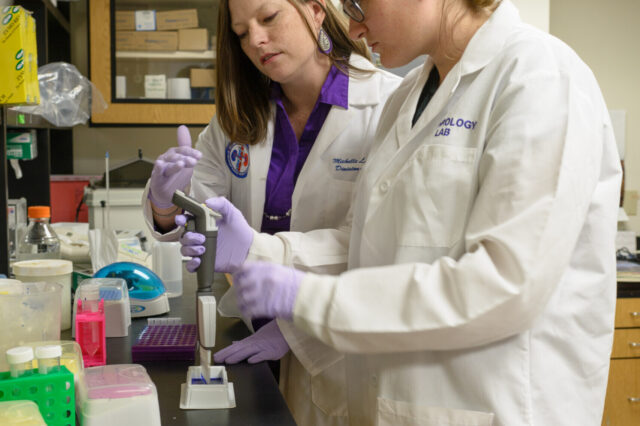UF Health researchers find possible clue about sex differences in heart disease

Circadian rhythms, the cellular timekeepers that are one of the cornerstones of biology, tune the human body to the rotation of the planet.
Body temperature rises as the day begins. By late morning, glands begin to secrete peak levels of testosterone as our alertness rises. Cardiovascular efficiency and blood pressure hits its highest point by late afternoon.
Then, as we sleep at night, blood pressure dips by as much as 20 percent, except when that internal timepiece is thrown akilter.
Research about this failure of blood pressure to dip in some individuals has led UF Health nephrology scientists to a possible insight as to why younger women have a lower risk of heart disease than men at similar ages. In a new study, researchers found a circadian gene tied to this nighttime blood pressure fluctuation behaves differently in male and female mice, a finding with potentially important implications for human health.
People whose blood pressure doesn’t fall at least 10 percent as they sleep are called “non-dippers” by scientists, and research has shown that they have a higher risk of heart and chronic kidney disease.
“We know that non-dipping hypertension is less prevalent in females pre-menopause, compared with males,” said co-lead author Lauren Douma, Ph.D., a postdoctoral fellow in the laboratory of Michelle Gumz, Ph.D., an associate professor in the UF College of Medicine’s division of nephrology, hypertension and renal transplantation. “But after menopause, it becomes the opposite. Then there is a higher incidence of non-dipping hypertension in females.”
Gumz also is a co-author of the study, published in the American Journal of Physiology –Regulatory, Integrative and Comparative Physiology.
The study examines the circadian gene called PER1. Previous research by Gumz and colleagues demonstrated that male mice missing the PER1 gene develop non-dipping hypertension in response to a high salt treatment. Their blood pressure doesn’t fall during their sleep cycle.
In the current study, the experiment was repeated on female mice. This time, results suggested that, despite PER1 being knocked out, the circadian rhythm of the female mice was maintained, thereby protecting them from becoming non-dippers.
Researchers suspect ovarian hormones are playing a role in maintaining the circadian rhythm of the female mice, a hypothesis that will be tested in a future study.
Gumz said the study’s findings offer a potential clue as to why pre-menopausal woman are less likely to develop heart disease compared with men at similar ages. “Our findings suggest that part of the protection females are afforded pre-menopause has to do with the maintenance of circadian rhythms,” she said.
Their work also could one day help guide researchers to new drug targets to help control blood pressure or provide insight into when it is best to administer medication to control hypertension. For example, might it be more effective in some patients to prescribe medication for evening hours?
Reducing blood pressure in the evening allows the body to rest and reset, lessening stress on the cardiovascular system and organs such as the kidneys, Gumz and Douma said.
“When we disrupt our circadian rhythm, we’re throwing our body out of physiological balance and everything sort of gets out of whack,” Douma said. “That is why we feel cruddy when we have jet lag.”
Circadian rhythms, the biological clock encoded in the DNA of all cells, had not been well-understood until research on the topic blossomed in the 1970s and 1980s. As research accelerates, this internal cellular timepiece is starting to give up its secrets.
“This specific study really represents the beginning of what could be a long-term line of investigation,” Gumz said. “I feel like we’ve barely begun to scratch the surface of what is happening.”
UF Health collaborators with Douma and Gumz on the study were co-lead author and graduate research assistant Kristen Solocinski, Ph.D., who now is a postdoctoral fellow at the National Institutes of Health; lab assistant Meaghan R. Holzworth; postdoctoral fellow G. Ryan Crislip, Ph.D.; lab technician Sarah H. Masten; lab manager Kit-Yan Cheng; lab scientist I. Jeanette Lynch; Brian D. Cain, Ph.D., a professor in the UF College of Medicine’s department of biochemistry and molecular biology; and Charles S. Wingo, M.D., a professor in the UF College of Medicine’s division of nephrology, hypertension and renal transplantation.
About the author
